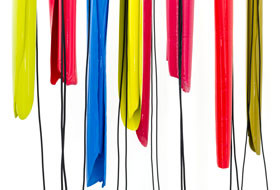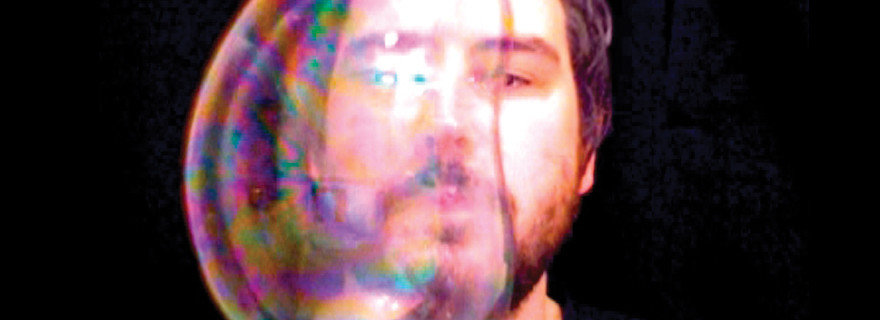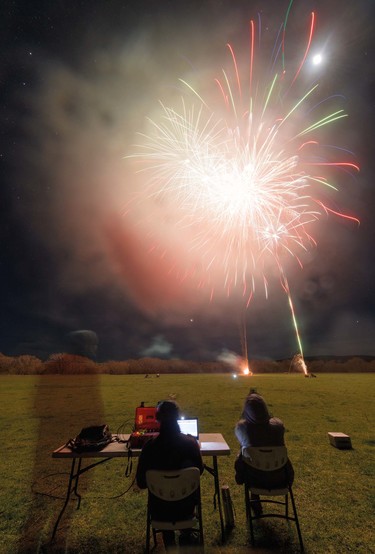
Everyone to Altitude
Making Chasing the Light
Late on a mild spring afternoon in mid-September, I travelled out of the city to a farm paddock somewhere up the line near Amberley, up front in a battered van carrying six drone pilots and their gear. The sun was low in the sky and Ōtautahi was framed in an arch of nor’west clouds. It was the first fine day in weeks.
We’d met outside a nondescript house in a northern suburb, exchanging names and awkward handshakes in that way you do when you know it’s unlikely you’ll see each other again. Ten people of diverse specialities stood around on the footpath sizing one another up, each gripped with the all-consuming intensity of a difficult job waiting to be done. The artist was dapper in a long wool coat and scarf; everyone else was wearing black puffer jackets and tramping boots. It was like the first act of a caper film, where the mastermind puts the crew together.
After an hour’s drive into wine country, we came to a stop in a large flat field at golden hour, the light streaming from under the clouds in great rays like a fifteenth-century painting. Steve Carr and the chief cinematographer, Caleb MacDonald, arrived in a separate car. The fireworks crew was already there. The field was bordered on one side by a creek and on another by a ridge-line topped with macrocarpa trees. Dozens of what looked like upturned mortars were being unpacked from crates. The big fireworks were still in the truck. As the sun began to go down behind the snow-capped mountains away to the west, we stood around, hands in pockets, cracking jokes and waiting for something to happen. A safety briefing. “You’ll need to be a hundred metres back,” said the fireworks chief, and pointed back across the field to where we’d come in. We got back in the vehicle and retreated to our position.
It nearly hadn’t happened at all. The shoot had been scheduled and postponed a dozen times over the previous few months. There was a long list of difficulties. It had been the second wettest June since written records began, an uncharacteristic run of weather that turned the city’s rough shingle carparks to mud and brought about a general feeling of malaise among its citizens, used to the bright clear cold days of midwinter in Christchurch. Steve and I scanned the long-term forecasts closely and with an increasing incredulity, texting one another the bad news. “We can’t shoot in the rain,” he said. “It just doesn’t work. When you see the rain in a film it’s always fake, there’s someone making it out of shot. We need a clear day.”
And then there was the availability of the six drone pilots, an elite group of cinematographers based in New Zealand but in demand around the world. One was just back from the US where he’d shot a documentary about three people who’d been trapped together in the Hotel Grand Chancellor during the February 2011 Christchurch earthquake. I thought I recognised another couple from the lounge of a regional New Zealand airport a few months earlier, where I’d overheard them talking about their airpoints.
The endless rain, the pilots and their work, the availability of the field, the seasonal work of the farm... and finally the flock of sheep that appeared in the paddock next door, with the neighbouring farmer overseas for a week and uncontactable. “That’s funny but also not funny at all,” I texted Steve. “I love all the things that have needed to be juggled to shoot for 1 night,” he replied. “If no sun we will reschedule for August.”
It was September in the end, with the evenings getting longer and the opening date of the exhibition getting closer. As the light faded in the paddock that night the pilots immediately set to working on their drones. What were they doing? I had no idea. Each had a control panel like a tablet screen. Steve explained that usually they fly by simultaneously looking up at the drone in the sky and tracking it on the screen. But they wouldn’t be able to see themselves tonight, up there in the dark. They only had the screens, so they were flying blind.
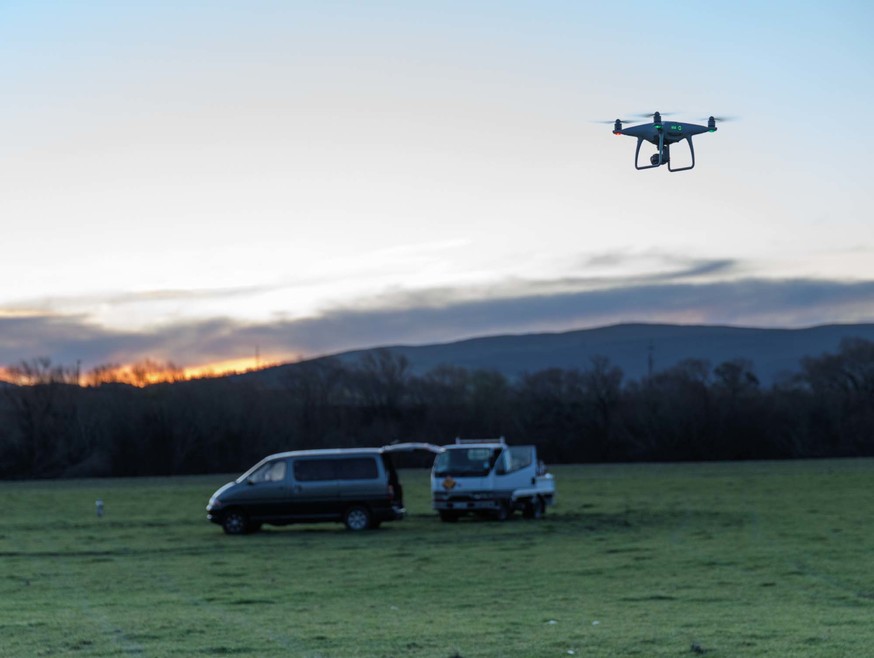

The huge open sky is dramatic at sunset in North Canterbury, out on the plains at the beginning of the foothills: the clouds that night were a wash of robin’s egg blue, metallic apricot, a greasy gun-metal grey. The winter trees were skeletons against a field of glorious colour. Then the first stars were out, and it was suddenly very cold. We waited for the test blast to go off, sitting on camp chairs in a freezing paddock as the sun went down.
The farmer whose field it was arrived, grinning, hands on hips. His excited little boy hung out of the window of his ute. “Are you the art gallery lady? When will they let off the fireworks? What’s this going to look like in the end?”
As the drones rose like a swarm of angry bees their lights flickered, green on one side, red on the other. Is it like port and starboard on a ship, I wondered. There was no one to ask so I wrote it down in my notebook anyway. The first firework exploded and the drones chased it around the sky before landing again. The last colour had completely drained out of the field. Above us was the great black vault of the night. The moon was ridiculously white, a beaten disk, like something in an eighteenth-century print. It was so dark you could see the Milky Way. The field was briefly illuminated by two wavering headlights. My colleague Vicky Flannery was back from Amberley with pizzas for dinner (“An odd experience”, she said. “I’ll tell you later.”)
The farmer’s father, the old farmer, arrived. “I was up the hill this morning moving the sheep. Looking out that way you could see seven ridges of hills at once. Clear to the mountains. A beautiful morning.”
Another briefing from the fireworks chief. “No point anyone going over 200 metres. The effects will be happening in the 100–150 metre area. The smaller calibre shells are a little lower. It’s hard to completely predict it, because you can’t ever count on the calibre. We’ve had a lot of variation of the stock over the years. In the event someone gets knocked down, I have control over every effect, they’re not strung together on a single fuse. We can stop.”
“If someone goes down, someone goes down,” said the artist. “The show goes on.”
It was so cold! And finally the last pale grey sliver of light was extinguished behind the distant mountains. I remembered this bone-chilling cold from every film shoot I’d ever been on. I wished I’d brought a hot water bottle, a warmer scarf. The drone pilots were talking about a colleague who’d once spent US$400 on heated socks.
In the dark field I noted down all the light sources now the sun had disappeared. The moon, the stars, the phosphorescent glow of tablet screens, a camping lantern, a klieg light powered by a small generator, the soft interior light when a car door opened, the weak green illumination of my phone screen as I scribbled notes. And then the flashing navigation lights of the drones lined up on the grass.
“Watch out for the Tangler,” said the fireworks chief from his desk, with a heavy note of warning in his voice. “If the Tangler hits a drone, it’ll bring it down.” (I couldn’t help but feel I would quite like to see that, and I suspected in this company that I probably wasn’t alone.)
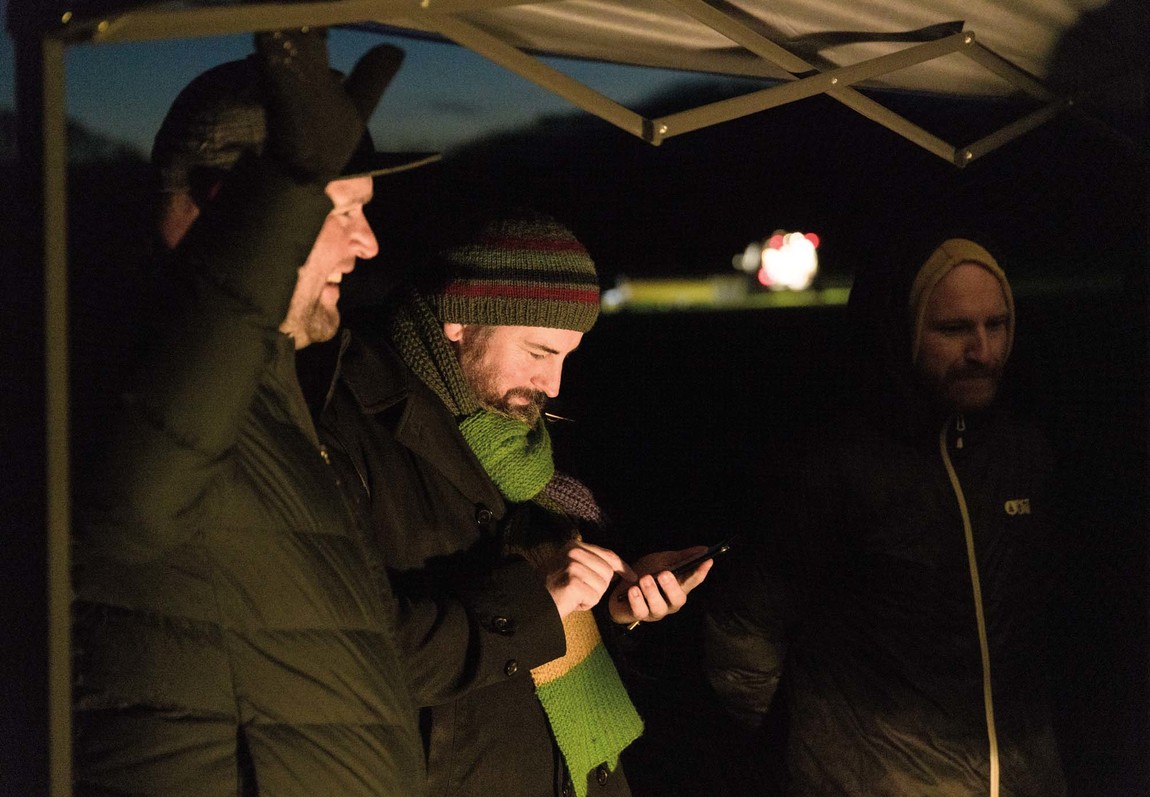
The drone pilots spread out across the field, each twenty metres apart. Their Wi-Fi was interfering with each other. The pilots wouldn’t be able to see their drones in the sky, and they weren’t sure if they were going to be able to see anything at all on their screens. They were impatient to be up and flying.
“The drone knows its own battery life,” said Caleb. “After a certain point, it just returns home. We’ve got to time it right.”
The crew were stamping their feet, trying to keep their boot soles off the cold ground, blowing out their breath like horses. The South African drone leader dropped to the ground and did twenty quick press-ups, some with claps. He got up, went on. No one said a word.
“We’ll get the drones in the sky. We’ll give you a signal when we’re in position.”
The angry bees rose again. The fireworks crew were making final adjustments. Caleb and Steve were making Top Gun jokes. Vicky and I were sitting on the two camp chairs, looking at the screens then up at the vast dome of the night, pizza boxes piled at our feet. I answered an email from my canvas chair in the middle of the dark field, wearing gloves.
Now the fireworks chief was sitting at the desk counting down for the second test firing. “Five... four... three... two... one.” BANG! BANG! Stars burst over the paddock. The night sky was momentarily filled with colour. Birds flew squawking from the trees. It was happening.
“I wasn’t expecting it to be quite so loud,” I said, weakly.
“Smoke ’em if you’ve got ’em!” said Steve over his shoulder, running between drone positions, trying to see all the screens at once.
The farmers’ sons were wrestling on the damp grass and the cameramen were telling war stories while they waited for the big push. “I wonder how many drones he’s written off now?” said one about a mutual colleague. “It’d be in the forties.” Another conversation, half-heard: “And then the battery died and I saw the drone drop from the sky. Exploded on to the concrete. I lost all the footage. Years ago now.”
Final briefing. It was so dark I couldn’t see to write in my notebook anymore. I filled it with mad stuff I couldn’t read the next day. Something about a tail slate. “It’s not the kind of show where the good shit happens at the end,” said Steve. “It happens all the way through. No build up. No money shot.” Everyone nodded in the dark.
One of the pilots asked if they could play music while they’re flying. “No,” said the artist firmly. “I don’t want you moving in sync. I want each of you doing your own thing. You’re chasing the same thing from different angles. I want you to create cinematic shots. Respond to what you see. It’s fine if you see each other out there. This is about recording you guys in a performative moment.”
And then: It’s time for the big one.
“Is that Top Gun?” I whispered to Vicky. “I think so,” she said.
Steve and Caleb were reviewing the test footage one more time. One of the camera operators pointed at the screen. “Is that a dead pixel, or is it a star?” “It’s a star,” said Caleb. “I think. Hard to say.”
They were ready. It was pitch black. The fireworks guy gave the signal. Steve gave the final wave.
“Everyone in focus?” asked Caleb. “Everyone to altitude. Rolling.”
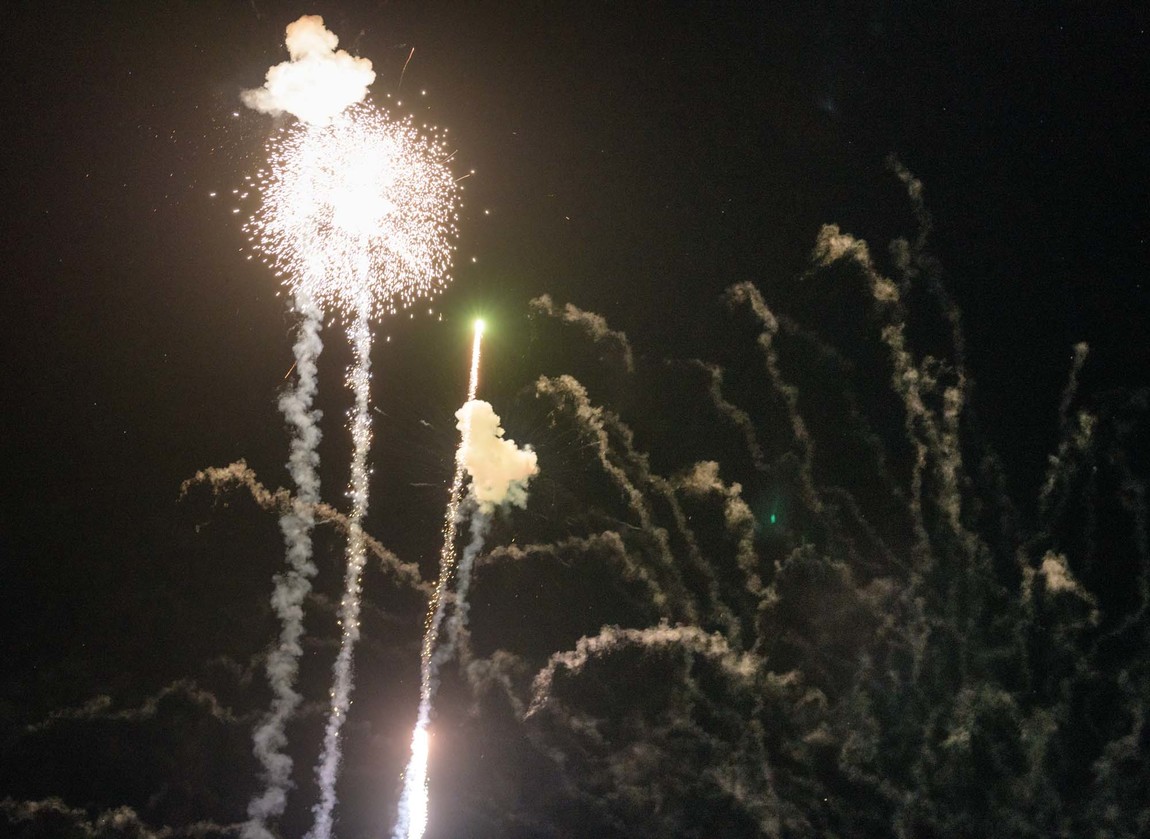
When the fireworks ignited, they lasted a full eighteen minutes, and it was like World War III out there in the paddock in the cold North Canterbury evening. The barrage of sound hit you in the sternum, and between the eyes, and at the back of the throat—it was impossible to do anything but look out and up at the fireworks exploding across the sky. The drones were circling at a range of altitudes, twenty metres in height between them when they started, though that went out of the window when they started chasing the lights. The explosions burst up through the drones, all the fireworks you know from public displays like screamers and shooting stars and red white and blue puff balls and the beautiful white ones like the seed head of a dandelion, but also peculiar fireworks that came snaking up from the ground like pillars of coloured smoke, like bombs detonating in a battle zone, like footage of hot wars on TV, 100 metres away, happening right where you are, you’re amongst it, it’s all-consuming. Afterwards no one could say anything at all for several minutes, shell-shocked by the spectacle.
Later we learned that the drones had frequently been clipped by the exploding ordinance, and that some took direct hits, during which the pilots lost all communications and were literally flying blind until they came back online. And that Steve had decided at the last moment to make the work in a single take, due to his confidence in the cinematographers’ rough footage. One eighteen minute take, no cuts, the same action seen from six different views at once, looped when it’s played in the gallery—a concentrated action happening at the same time and in a single place, a six-part film existing somewhere between John Woo’s violent aerial gun ballets and Tarkovsky’s meditations on the nature of time in the cinematic frame. Steve cites the long hot air balloon sequence in Tarkovsky’s Andre Rublyov (1966) as a critical point of reference: the aerial view of the world, the crash, the horse struggling to get to its feet; the dream, the fall, the symbol of life. The six Phantom drones’ batteries lasted just over twenty minutes, and by the last moment the pilots were frantically overriding their pre-programmed desire to come home, fighting to capture the final few seconds of the display before the machines glided gently to earth.
“Was that vertical one a Tangler?” asked one of the pilots. “Did you see the Tangler?”
No one saw the Tangler.
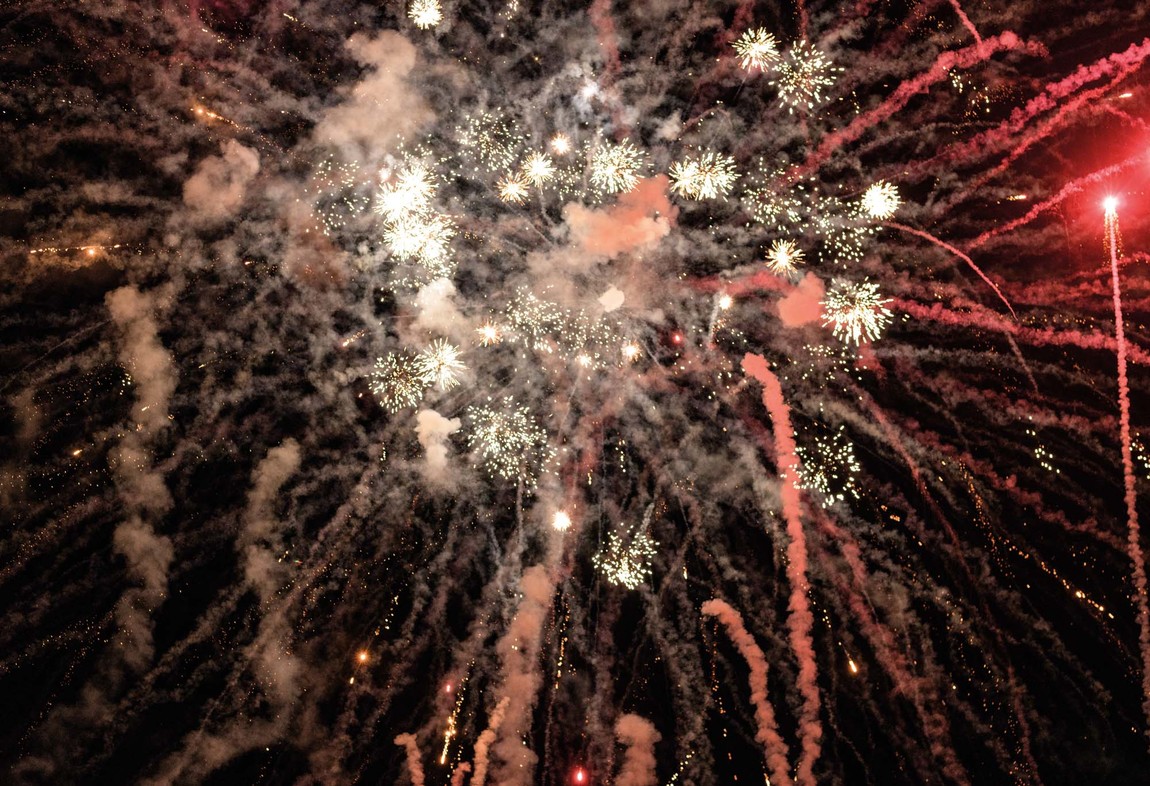
Ten days later, Chasing the Light is just about to open in Christchurch, and Steve and I are walking around the gallery in the dark, thinking about the work. Six individual films of the same eighteen minutes’ worth of action, shot from different altitudes and angles by six different camera operators, each projected on to a separate screen (made from rusted steel, to look like drive-in movie screens from the 1950s or 1960s). You can see two or three screens at once, but not all of them, and as you walk around the gallery to see more you become aware of your body’s presence in the room, looking at the work, travelling from one point to another like the drones moving through space. It’s a feeling I’ve had when watching Steve’s earlier films like Burn Out (2009) or Watermelon (2015)—the critical moment when I’ve suddenly become aware of myself looking, when the subjectivity of the work not only compels a response from your own subjectivity, but also brings about an awareness of your own subject position in relation to what you are watching.
“I’m surprised by how nostalgic this work feels,” says Steve. “I didn’t intend to make it nostalgic, but it’s about memory.”
Chasing the Light is a silent installation. The noise of the fireworks would create tension, Steve tells me, but in a silent room you become aware of yourself in the space. Besides, he would have had to record the sound from the ground while the action was going on up in the air; there would have been a lag, a delay. Your usual experience of fireworks is as much about the sound as it is about the vision, and when you’re watching them, the further you are away the longer the sound takes to reach you. Removing the sound entirely changes the experience of seeing them. “Being in the space but not being allowed to have the full experience,” says Steve, “it becomes a reflective exercise on what you know about fireworks already. That’s what you bring to it. Memory.”
In Chasing the Light you respond to the elemental beauty of the explosions; streams of light shoot past the camera lens like tongues of flame or tracer fire in an aerial dogfight. Fire erupts and disperses as smoke. Rather than being on the ground looking up at a sonic performance, the viewer is immersed in an impossible boundless space, lost in the silence of a dream. With no horizon line or point of reference, fireworks burst across the screen in a disorientating sequence like a barrage of artillery experienced at close range. It’s as if you’re up there, flying among them.
“You and I will remember that night for the rest of our lives, and when I watch the film I’ll always think about it,” Steve observes. “It was explosive and intense and terrifying, but the experience of the film is the complete polar opposite to what we experienced. It reminded me of making my earlier works, shot on film. Although this was digital the viewing screens were tiny, and I didn’t know quite what I’d got until I’d got into the editing suite.”
“You were very calm, that night in the paddock,” I observe.
“Well,” he replies, “on most of my films, I’m fairly confident on the day of the shoot because it’s just about recording that moment. It’s not so much about capturing a perfect moment, just the moment that I’ve set up. Coming from a performance-based background, you respond to what happens on the day. In theory, nothing can go wrong, apart from equipment failure.”
There’s a lack of bombast in Chasing the Light which is possibly a little surprising, given the subject matter. More than anything the film is reserved; it’s refined and elegiac and a little melancholy. That sets it apart from the thousands of firework videos people have posted to YouTube, which attempt to capture their percussive sound and fury, and which lead up, as fireworks displays always do, to the grand finale. In Chasing the Light there are any number of false finales; the tension builds but is never dispersed in a final explosive conflagration.
I clear my throat. “Can we talk about euphemisms?” I ask.

“Well, I expect there’s a euphemism there,” says Steve. “Sure. Yes, of course it’s there. At one level it’s an easy gag about male and female orgasms. But clearly the work is slower and more subtle than that. The build-up of fireworks is always the ecstasy moment, and that’s what I didn’t want the fireworks people to do. When I first thought of the work three years ago, I knew that reading would inevitably be there. But when I met those six cinematographers, that was the switch. I hadn’t realised that this would be so hard to shoot. It’s a work that showcases the extraordinary skills of those guys— like my film Aona, about grooming the prize-winning Japanese poodle, or Mercury Rising, about the Freddie Mercury tribute artist. So Chasing the Light relates to my earlier works in that way. A number of strands of my practice merge together in it.”
Chasing the Light was both shot and exhibited in darkness. There are moments during its eighteen-minute cycle where there is little happening on any given screen. When you spend time with the work, you gradually become aware that the same event is being captured from multiple viewpoints. A firework explodes on one screen and fires at a different angle across another while its after-effects—disintegrating light, clouds of smoke, a distant flash—are caught by other cinematographers and projected on adjacent screens. No screen is ever entirely dark, though. Tiny points of light—the navigation lights of other drones, a car driving down the highway, a house’s light seen from a high altitude—are always moving through the shot.
There are moments of great beauty, moments of bleakness, moments in which the drones have lost control, moments in which the ground is suddenly lit up by an explosion detonating at a low altitude, and even a second where the skeleton trees at the boundary of the field are visible, if you know what you’re looking for. Chasing the Light entirely changes your perception of fireworks; everything you think you know about them, everything you bring to the experience of looking, is disrupted by the work, which is stranger and more beautiful than anything you could imagine.









